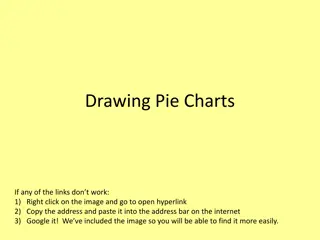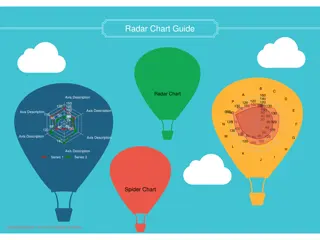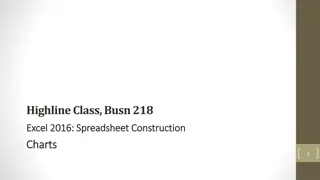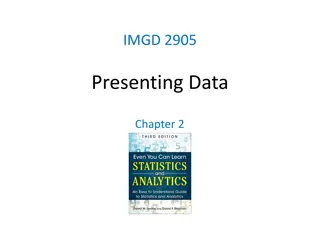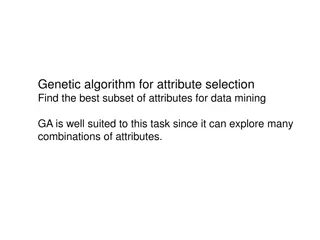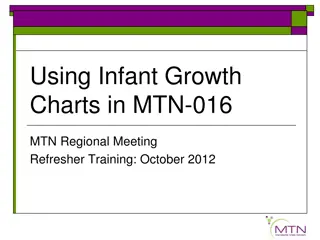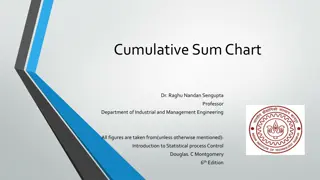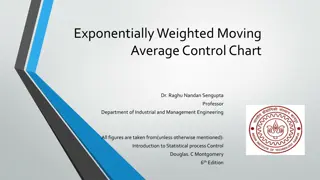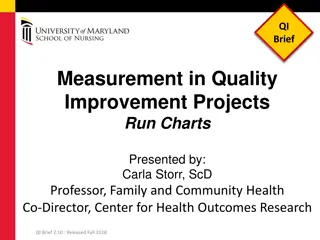Overview of Attribute Control Charts in Quality Management
Attribute control charts are used in quality management to monitor the conformity of products or services based on specific characteristics. Unlike variable charts, attribute charts categorize items as conforming or non-conforming. This summary discusses the importance of attribute charts, focusing on the control chart of fraction non-conforming (p-chart), statistical principles, and the development of p-charts including calculations and limits.
Download Presentation

Please find below an Image/Link to download the presentation.
The content on the website is provided AS IS for your information and personal use only. It may not be sold, licensed, or shared on other websites without obtaining consent from the author. Download presentation by click this link. If you encounter any issues during the download, it is possible that the publisher has removed the file from their server.
E N D
Presentation Transcript
ATTRIBUTE CONTROL CHART Dr. Raghu Nandan Sengupta Professor Department of Industrial and Management Engineering All figures are taken from(unless otherwise mentioned): Introduction to Statistical process Control Douglas. C Montgomery 6thEdition
Attribute Charts Consider a glass container for a liquid product We examine the container and classify it into one of the two categories called conforming or non- conforming, depending on whether the container meets the requirements on one or more quality characteristics This is an example of attributes data Attributes charts are generally not as informative as variables charts because there is typically more information in a numerical measurement Attribute charts are particularly useful in service industries and in nonmanufacturing quality- improvement efforts
Control Chart of fraction non- conforming (p chart) The fraction nonconforming is defined as the ratio of the number of nonconforming items in a population to the total number of items in that population Of multiple quality characteristics even if one is not met, the item is said to be nonconforming Sometimes fraction conforming is also studied and we get a control chart on process yield
Statistical Principal of fraction non- conforming Basic underlying principle Binomial Distribution Let p be the probability that a unit will not conform to the specifications All units produced are independent If a random sample of n units is drawn and D is the number of Defective units, then D will follow a Binomial Distribution Sample fraction nonconforming
Development of the p chart When p is known: When p is not given: First we estimate p from one sample Then we estimate the average p for all the samples
p Chart Calculations Final we calculate the limits Limits calculated from initial samples should be treated as trial control limits Usually some target value of p is given for the chart
Solution First we estimate p Then we estimate the control limits Based on the above calculation we plot the initial chart
Solution Points 15 and 23 are out of control It was found that point 15 and 23 were samples obtained from testing a new raw materials supplier and new operator (assignable causes) These points were removed and the limits were recalculated
Solution The new points are calculated the chart is gain plotted
Some considerations while designing the p chart (Calculating n) If p is very small, we should choose n sufficiently large so that we have a high probability of finding at least one nonconforming unit in the sample. Duncan (1986) has suggested that the sample size should be large enough that we have approximately a 50% chance of detecting a process shift of some specified amount Where L=number of sigmas used for limit calculation and =magnitude of the shift If the in-control value of the fraction nonconforming is small, another useful criterion is to choose n large enough so that the control chart will have a positive lower control limit
R code mat<-matrix(nrow=20, ncol=2) mat[,1]<-seq(1:20) mat[,2]<- c(3,2,4,2,5,2,1,2,0,5,2,4,1,3,6,0,1,2,3,2) library(qcc) P<-qcc(mat[,2],type="p",sizes=150)
Calculation of sample size Using formula We use p$center to get estimate of p L=3 So n>((1-.0166)*9)/(.0166) n>533.167 or n>534
The np control chart It is also possible to base a control chart on the number nonconforming rather than the fraction nonconforming Calculation of the limits If p is not available, p can be used It is easier to interpret
R code data<-matrix(nrow=20,ncol=2) data[,1]<-seq(1:20) data[,2]<- c(230,435,221,346,230,327,285,311,342,308,456,394,28 5,331,198,414,131,269,221,407) library(qcc) qcc(data[,2],sizes=2500,type="np")
Variable sample size-1stmethod. Variable-Width Control Limits The most simple approach is to determine control limits for each individual sample that are based on the specific sample size That is, if the ithsample is of size ni, then the upper and lower control limits are
Method II Control Limits Based on an Average Sample Size This assumes that future sample sizes will not differ greatly from those previously observed
Control chart for non-conformities(c chart) Each specific point at which a specification is not satisfied results in a defect or nonconformity. a nonconforming item will contain at least one nonconformity depending on their nature and severity, it is quite possible for a unit to contain several nonconformities and not be classified as nonconforming suppose we are manufacturing personal computers. Each unit could have one or more very minor flaws in the cabinet finish, and since these flaws do not seriously affect the unit s functional operation, it could be classified as conforming if there are too many of these flaws, the personal computer should be classified as nonconforming, since the flaws would be very noticeable to the customer and might affect the sale of the unit
Method III The Standardized Control Chart Such a control chart has the center line at zero, and upper and lower control limits of +3 and 3, respectively Where p is process fraction nonconforming in the in-control state
Examples Method II Method I
OC Function and Average Run Length The OC curve provides a measure of the sensitivity of the control chart that is, its ability to detect a shift in the process fraction nonconforming from the nominal value p to some other value p. The probability of type II error for the fraction nonconforming control chart : Since D is a binomial random variable with parameters n and p, the b-error defined in equation (7.15) can be obtained from the cumulative binomial distribution
Average Run length when in control Consider the control chart for fraction nonconforming used in the OC curve calculations in Table 7.6. This chart has parameters n = 50, UCL = 0.3697, LCL = 0.0303, and the center line is p. From Table 7.6 (or the OC curve in Fig. 7.11) we find that if the process is in control with p = p, the probability of a point plotting in control is 0.9973. Thus, in this case = 1 = 0.0027, and the value of ARL0 is
ARL when process out of control Now suppose that the process shifts out of control to p = 0.3. Table 7.6 indicates that if p = 0.3, then = 0.8594. Therefore, the value of ARL1is
Control Chart for Average Number of Non-conformities It is possible to develop control charts for either the total number of nonconformities in a unit or the average number of nonconformities per unit These control charts usually assume that the occurrence of nonconformities in samples of constant size is well modelled by the Poisson distribution. This requires that the number of opportunities or potential locations for nonconformities be infinitely large and that the probability of occurrence of a nonconformity at any location be small and constant The inspection unit must be the same for each sample
Calculation of limits Suppose that defects or nonconformities occur in this inspection unit according to the Poisson distribution x is the number of nonconformities and c > 0 is the parameter of the Poisson distribution If calculated LCL<0, set LCL as 0
When c is not specified If no standard is given, then c may be estimated as the observed average number of nonconformities in a preliminary sample of inspection units - say, c
C chart Two points plot outside the control limits, samples 6 and 20 Sample 6-> new inspector Sample 20-> temperature control problem
Calculation of new control limits First new c is calculated The control limits are also recalculated
R code data<-matrix(nrow=25,ncol=2) data[,1]<-seq(1:25) data[,2]<- c(1,0,4,3,1,2,5,0,2,1,1,0,8,0,2,1,3,5,4,6,3,1,0,2, 4) library(qcc) qcc(data[,2],type="c",sizes=25)
The u chart(Average Number of non conformities) In the earlier case we assumed a 1 unit sample size However we can increase the sample size in which case when we create the chart, we have to consider average number of non conformities If we find x total nonconformities in a sample of n inspection units, then the average number of nonconformities per inspection unit is
Calculating control limits for the u chart u represents the observed average number of nonconformities per unit
Calculation of Control Limits Since LCL<0, for the chart we set LCL=0
R code mat<-matrix(nrow=20, ncol=2) mat[,1]<-seq(1:20) mat[,2]<-c(2,3,8,1,1,4,1,4,5,1,8,2,4,3,4,1,8,3,7,4) library(qcc) qcc(mat[,2],type="u",sizes=50)





